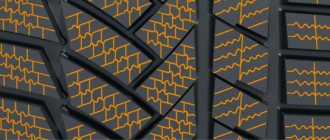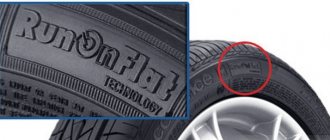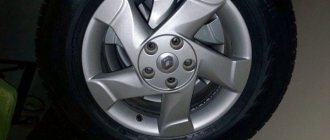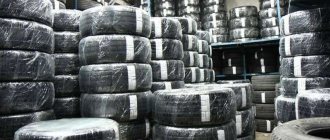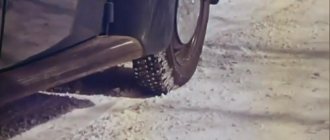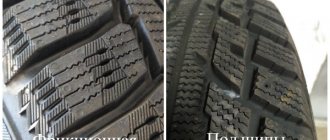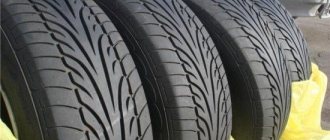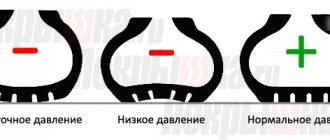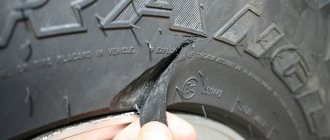Greetings to all readers of my blog! Despite the late arrival of spring this year, everyone has probably already changed their “iron horses” into light summer shoes. On summer tires, the car responds more willingly and sharply to turning the steering wheel, accelerates with much less slippage at start, and as a pleasant bonus we get slightly reduced fuel consumption. I would like to say that I also changed the tires on my Volkswagen quite a long time ago, installing standard tires with dimensions 195/55 R15. Today’s article is dedicated specifically to rubber, and more specifically we will talk about what low-profile tires are. Is it even needed on our “excellent” roads? I will tell you my story and maybe I will warn many from mistakes. So, let's go...
Advantages and disadvantages of low profile tires
First of all, it's appearance. A car, especially with large rims, “shod” in low-profile tires, certainly looks more attractive than exactly the same one, but on regular tires.
What else is good about such tires?
Cars are becoming faster and faster, with the help of turbocharging more and more power is removed from a unit of engine displacement. But high speeds also require good braking performance, which is influenced primarily by the size of the brake disc and the width of the tire contact patch with the road surface.
To increase the diameter of the brake disc, it is necessary to increase the size of the wheel itself, which is limited by the size of the wheel arches. This means that to maximize the size of the rim, it is necessary to reduce the height of the tires on it.
To increase the area of the contact patch, it is necessary to expand the tire itself, which will also allow even more air to be pumped into it. The result is excellent tires with high speed characteristics: the speed index of low-profile tires is always higher than that of regular tires.
In addition to good braking characteristics, the car on such wheels rolls less when cornering, which, taking into account the increased braking and grip properties (wide contact patch), improves the car's handling and maneuverability.
But there is also another side to the coin
- First of all, this is the use of low-profile tires on roads with poor-quality surfaces, which is very important for Russia. Driving on such tires will be worse in terms of comfort than riding on high-profile wheels.
- It is quite easy to break through the suspension of a car on such tires; the chassis parts will wear out faster: ball joints, wheel bearings, etc. In addition, if you hit a significant obstacle, you can easily split the wheel rim.
- Increasing the contact patch also increases the sound made by the tire in motion. There are no narrow, low-profile tires, which means driving on them reduces acoustic comfort.
- With wide tires, the likelihood of aquaplaning also increases, since it is more difficult to quickly remove water from under such a wheel than from under a narrow one.
- Increased steering load - wide wheels are more difficult to turn than narrow ones.
- The need to frequently monitor tire pressure. Its insufficient value is fraught with serious problems, since there is already so little air in such a wheel, even a small loss of it will affect the durability of the disk and suspension.
- Price. Low profile tires are always more expensive than high profile tires. And the standard wheels will have to be replaced with wider ones.
Varieties
There is no specific classification applied to low profile tires.
Basically, such rubber is distinguished by profile size. According to current generally accepted standards, any tire with a profile of no more than 55% is classified as low profile. Previously, a different standard was used, corresponding to 70%. And the current trends in the development of the tire and automobile industry will soon likely lead to the fact that 55% will no longer be considered a low profile, and the report will start with 50 or even 45%.
You can also divide tires by the pressure that should be inside the low profile rubber. Which pressure parameters are used depends on several factors.
So what should you choose?
This is what the TOP summer tires for passenger cars look like, based on the greatest popularity among domestic motorists:
Low profile, summer, passenger cars
- MICHELIN Primacy 3 - controlled braking and excellent handling, excellent grip, both on dry and wet roads. They are the optimal choice for urban travel.
- Viatti Strada Asimmetrico V-130. A new brand on the tire market. Joint development of Italian designers and German engineers. The most modern technologies and materials are used to produce these tires.
- Continental ContiPremiumContact 5. An ideal, but not cheap tire that demonstrates an increased level of safety. The rubber features excellent road grip and excellent handling in all situations, short braking distances and high energy efficiency.
- MICHELIN Primacy 4. Tires with an asymmetric tread pattern that demonstrate a high level of performance even in heavily worn conditions. 2021 model.
- MICHELIN Energy Saver. Reliable grip and short braking distance, asymmetrical tread pattern, reduced rolling resistance.
Low profile, summer, SUVs
For SUVs the picture is as follows:
- MICHELIN Latitude Sport 3. One of the latest developments from French tire makers, which is optimally suited for sports crossovers and can be used at speeds above 200 km/h.
- Bridgestone Dueler H/P Sport. The tires are stable in any road situation, always have excellent handling, stability at high speeds and comfort.
- Continental ContiCrossContact UHP. It has high performance characteristics, in addition to crossovers, it is also great for large SUVs.
- MICHELIN 4x4 Diamaris. Rubber with an asymmetrical directional tread pattern has excellent grip on any road surface.
- Toyo Proxes T1 Sport SUV. The use of a heavy-duty frame with additional reinforcements helps maintain directional stability at high speeds.
Low profile, winter, passenger cars
Winter low-profile tires for passenger cars:
- Nokian Nordman 5. Studded tires, which are an analogue of the famous Hakkapeliitta 5 tires. Good value for money.
- Nokian Hakkapeliitta 8. A relatively new model that has won a variety of tests conducted by journalists from many countries.
- Yokohama Ice Guard IG55. One of the new products from the Japanese manufacturer, very popular in Russia. The rubber compound consists not only of traditional silica, but also of orange oil, which gives the tire additional positive qualities.
- MICHELIN X-Ice North 3. The tire was created using the latest developments from the French manufacturer.
- Sava Eskimo STUD. This is a modernized version of the popular Goodyear UltraGrip Extreme model, which has proven itself in its time.
Low profile, winter, SUVs
The TOP for SUVs currently looks like this:
- Nokian Hakkapeliitta 8 SUV. The same eighth Hakka described above, but with a reinforced frame for use on crossovers and SUVs.
- Pirelli Scorpion Winter. One of the latest developments from the Italian manufacturer, which is designed for premium SUVs.
- Nokian Hakkapeliitta 9 SUV. A new model from the Finnish concern, developed on the basis of the Hakkapelit 7 model. Well suited for machines that operate in harsh conditions. It has a special studding system.
- MICHELIN Latitude Alpin LA2. Tire for SUV cars and for warm European winters. No thorns.
- Continental ContiCrossContact Winter. A new product with an asymmetric tread pattern that demonstrates excellent handling on both snowy and dry winter surfaces.
After reviewing the pros and cons of low-profile tires, think about what you value more: comfort or speed? What riding style do you prefer? What surface do you travel on most often? Do not forget that for a better aesthetic perception, such tires must be fitted with a beautiful “casting”, and not with standard “stamping”.
Let's turn to the TOP high-profile tires. So, Russian motorists prefer the following high-profile summer tires for passenger cars:
High profile, summer, passenger cars
- MICHELIN Energy XM2. A very durable tire, a good option for poor road surfaces.
- Toyo Proxes CF2. Most often used on high-speed cars.
- Nokian Nordman SX2. Tires for family cars, which are mainly used in the city.
- Continental ContiPremiumContact 5. Demonstrates excellent performance, short braking distances on any road surface, high energy efficiency and controllability.
- Bridgestone Turanza T001. It is stable at high speed.
High profile, summer, SUVs
- Viatti Bosco A/T. Quiet, comfortable, load-bearing and energy efficient.
- Tigar Suv Summer. Developed by specialists from Michelin. Excellent value for money and quality.
- Toyo Open Country U/T. A tire with an original tread pattern, improved grip and traction characteristics.
- BFGoodrich g-Grip. Unique V-shaped design, directional tread pattern and a number of other interesting solutions.
- BFGoodrich All-Terrain T/A KO2. A classic of the genre for off-road conditions.
High profile, winter, passenger cars
- Nokian Nordman. Durable and balanced rubber based on Hakapelite 5.
- Nizhnekamskshina Kama-Euro LCV-520. Modern innovative tire with balanced characteristics.
- Nizhnekamskshina Kama-Flame. Irregularly shaped blocks in the tread pattern make this tire very passable in winter conditions.
- Nizhnekamskshina Kama-505. Special directional pattern and 12 rows of Finnish studs with two flanges.
- Nokian Hakkapeliitta 8. Excellent wear resistance and road grip.
High profile, winter, SUVs
- Nokian Hakkapeliitta 8 SUV. The tire is the winner of all kinds of tests.
- Nokian Nordman 7 SUV. Designed for harsh winters, intended primarily for driving on asphalt.
- Pirelli Scorpion Winter. It is characterized by high stability and controllability, both on snowy and dry or icy roads.
- Bridgestone Blizzak DM-V2. The Blizzak series has been in the first positions in ratings and various tire tests for more than a decade.
- Dunlop Grandtrek Ice02. Tires mainly for asphalt.
Each driver chooses tires based on a number of factors, such as: cost, driving style, tire durability. Takes into account the conditions in which the car is most often used: off-road, dirt roads, country highways or city streets. To say that this or that rubber is better in all respects means lying, since many qualities contradict each other. For example, comfort and handling. Analyze the above factors, consult with tire store consultants, read specialized online forums, and you will definitely choose your tires.
What should the pressure be?
A logical question concerns pressure requirements. In the case of low-profile tires, this parameter is important. If you overinflate a tire, the level of comfort decreases and every bump makes your teeth chatter.
When the pressure in rubber decreases, the risk of overheating increases and the service life of the product decreases (high risk of damage).
To avoid problems, you should follow the recommendations of machine manufacturers. Some of them advise slightly increasing the pressure for such tires (by about 0.15-0.2 bar), but this condition is not necessary.
How to Determine If a Tire is Low Profile
To do this, you need to pay attention to the percentage ratio of the tire height to the width of its tread. Standard tire markings look, for example, like this: 225/45/R17, where the profile height is designated as 45, which is the above ratio expressed as a percentage
Standard tire markings look, for example, like this: 225/45/R17, where the profile height is designated as 45, which is the above ratio expressed as a percentage.
Currently, low-profile tires are those whose profile height index does not exceed 55%. All other tires are considered high profile.
A little history
The first low-profile tires were developed by Michelin back in 1937, but due to the poor condition of the vast majority of roads and, to put it mildly, the inadequacy of the technical parameters of cars of that time, they were not widely used. Low-profile tires received a rebirth in the late 70s of the 20th century, when they began to be installed on racing cars. From this moment on, the use of such wheels began - first in motorsport, and then in the “civilian” automotive industry. Today, almost all manufacturers offer model lines of low-profile tires.
Design features
As the name suggests, low profile tires have a low profile. What is a profile? This is the ratio of the height of the tire to its width, expressed as a percentage. It must be indicated on the tire marking (the second number after the slash). For example, for a tire designated 205/60 R16, this parameter is 60%. They say that in this case the tire has a 60 profile.
What tires are considered low profile? The criterion is precisely the profile value, which for low-profile tires does not exceed 55. It should be noted that the threshold of “low-profile” was constantly changing with the introduction of new technologies and the entry of advanced models into the market. For example, in the 70s, tires with an 80 profile were considered low profile.
Since such rubber was originally used for racing cars, among other tasks, there was a need to provide effective braking at high speeds and increase traction between the wheels and the road surface. Reducing the wheel profile helped solve the following design problems:
- It became possible to install brake discs of increased diameter.
- The tire width has been increased to ensure sufficient air volume inside the wheel.
